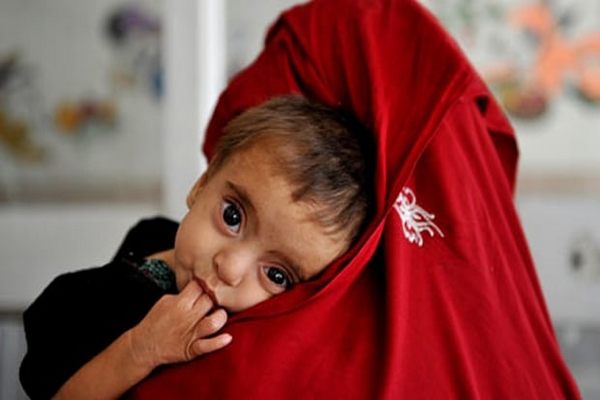Definition of Malnutrition in Children:
Malnutrition is an impairment of health resulting from a deficiency, excess or imbalance of nutrients. It includes under nutrition, which refers to a deficiency of calories and /or one or more essential nutrients and over nutrition which is an excess of one or more nutrients and usually of calories.
It may be defined as pathological state resulting from a relative or absolute deficiency or excess of one or more essential nutrient.

Classification or Types of Malnutrition in Children:
Various degree of malnutrition have discussed in the below:
1. Under nutrition:
This is the condition which results when insufficient food is eaten over an extended period of time.
2. Over nutrition:
This is the pathological state resulting from the consumption of excessive quantity of food over an extended period of time.
3. Imbalance:
It is the pathological state resulting from a disproportion among essential nutrients with or without the absolute deficiency of any nutrient.
4. Specific deficiency:
It is the pathological state resulting from a relative or absolute lack of an individual nutrient.
Causes of Malnutrition in Children:
Primary malnutrition or primary causes of protein energy malnutrition (PEM):
- Refusal to take food,
- Lack of food or means to have access to food 4. Fat foods,
- Lack of elementary knowledge of food and nutrition,
- Refusal to take food,
- Fat foods,
- Lack of teeth or inability to chew.
Secondary malnutrition:
- Disorders of the GIT,
- Fever,
- Protracted immobilization,
- Surgery,
- Drug therapy.
Preventive Measures of Malnutrition in Children:
By the below ways we can prevent malnutrition from our community:
1. International level:
- Co-operation should be increased between the developed and underdeveloped countries for food.
- International agencies such as – FAO, UNICEF, WHO are helping the government in different parts of the world against malnutrition.
2. National level:
- Population control.
- Increase in food production.
- Rural development & Industrialization.
- Proper storage and distribution of food.
3. Community level:
- Control of communicable diseases,
- Improvement of water supply,
- Health education,
- Significant improvement of overall living conditions of the people.
4. Family level:
- Family spacing and planning.
- Special care for nursing mother and children.
- Breastfeeding practice.
- Encouraging about poultry and vegetable garden.
- Education regarding nutrition and home economics.
- Sanitation of homes.
- Standardization of living.
Prevention of Malnutrition in Children:
A mother of a baby of low socioeconomic condition can prevent malnutrition of her baby by the following ways:
- Promotion of breast feeding,
- Low cost protein e.g. dhal,
- Planning a. kitchen garden or keeping poultry,
- Immunization against infectious diseases,
- Family planning,
- Nutritional education,
- Consultation with the local doctor.
More questions related to this article:
- What is malnutrition?
- What do you mean by malnutrition?
- What are the different types of malnutrition?
- What are the classifications of malnutrition?
- State the main factors of malnutrition in our country.
- List the main causes of malnutrition in our country.
- How will you prevent malnutrition from your community?
- How can a mother of a baby of low socioeconomic condition prevent malnutrition of her baby?

Maria Khatun Mona is a Founder and Editor of Nursing Exercise Blog. She is a Nursing and Midwifery Expert. Currently she is working as a Registered Nurse at Evercare Hospital, Dhaka, Bangladesh. She has great passion in writing different articles on Nursing and Midwifery. Mail her at “maria.mona023@gmail.com”
